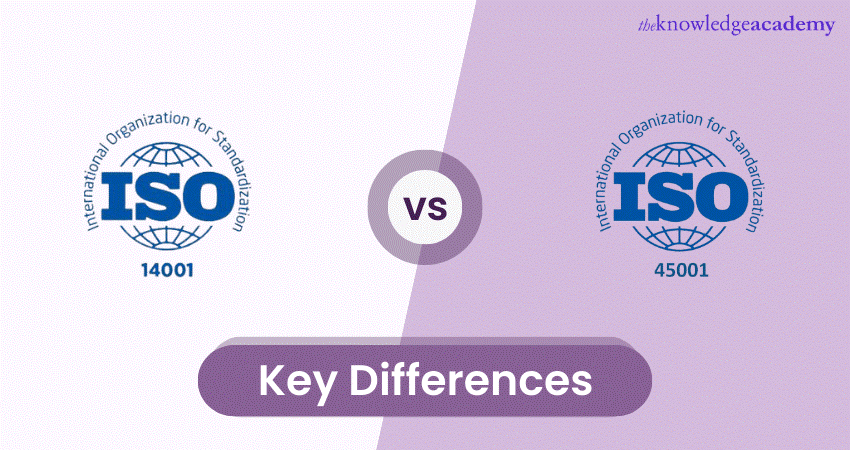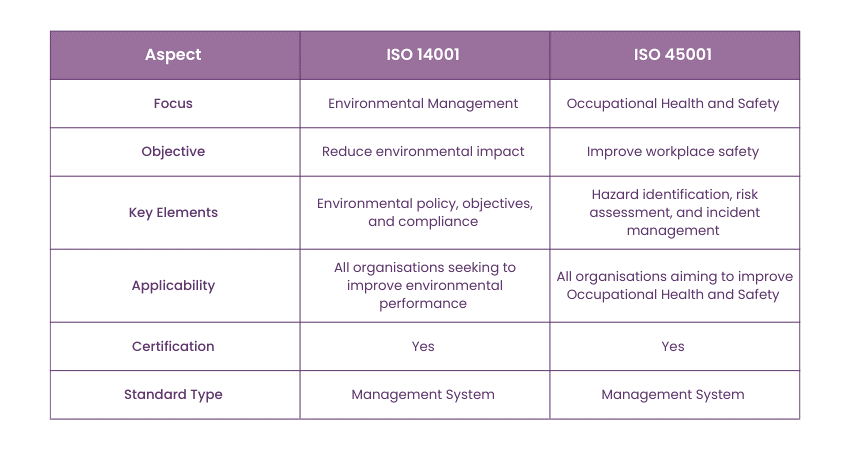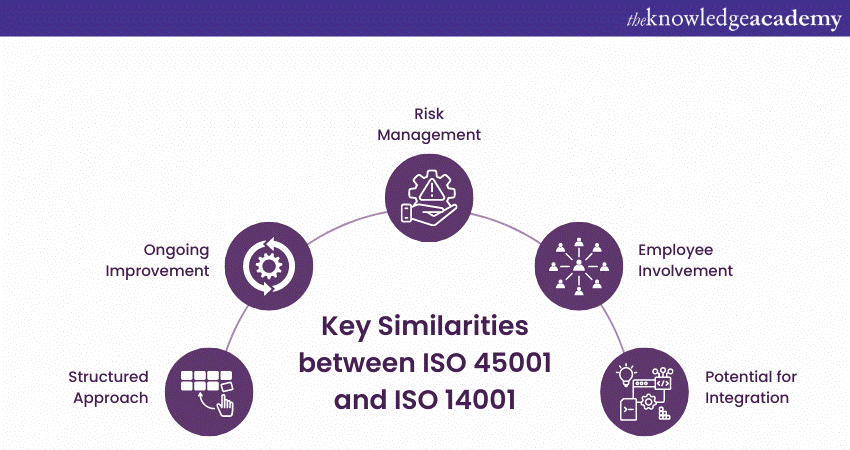We may not have the course you’re looking for. If you enquire or give us a call on +44 1344 203 999 and speak to our training experts, we may still be able to help with your training requirements.
Training Outcomes Within Your Budget!
We ensure quality, budget-alignment, and timely delivery by our expert instructors.

In today's competitive landscape, organisations strive to protect their employees, minimise environmental impacts, and meet international standards. ISO 14001 and ISO 45001 are globally recognised management systems designed to achieve these goals. However, understanding the difference between ISO 14001 and ISO 45001 is crucial for implementing the right standard tailored to your organisational needs.
ISO 14001 focuses on environmental management, while ISO 45001 targets Occupational Health and Safety. This blog will explore the key Difference Between ISO 14001 and ISO 45001, helping you make an informed decision for your organisation's future success.
Table of Contents
1) What is ISO 14001?
2) What is ISO 45001?
3) ISO 14001 vs ISO 45001 – Key Differences
4) What are the Similarities Between ISO 45001 and 14001?
5) Conclusion
What is ISO 14001?
ISO 14001 is an internationally recognised standard that defines the requirements for establishing an EMS. It provides suggestions that organisations may follow instead of setting standards for environmental efficiency. It helps organisations improve their environmental performance, reduce costs, minimise waste, and gain a competitive advantage and recognition in the market.
It is relevant to any organisation irrespective of its size, type and nature. The organisation details its environmental aspects of its business, products and services that it deems can be avoided or managed when embracing the ISO 14001 Life Cycle perspective.
Finally, through the implementation of ISO 14001, an organisation is able to achieve its environmental legal obligation. The benefits of implementing ISO 14001 comprise manageable wastes and energy, significant cost reductions, and reduced legal liabilities regarding the environment. It contributes significantly to an organisation’s battle against sustainable development.
What is ISO 45001?
ISO 45001 provides the Occupational Health and Safety Management Systems (OHSMS) specifications. Created by the ISO, 45001 is intended to provide organisations with a comprehensive structure for managing OH&S hazards and creating safe workplaces.
Its main goals are to protect workers from occupational injuries and diseases, reduce workplace dangers, and comply with existing legal standards. ISO 45001, for its part, uses a comprehensive approach to OHSMS that allows organisations to recognise and assess potential threats and implement adequate responses and measures.
The standard emphasises the active involvement of all workers in creating a safe and healthy work environment, developing a positive attitude to safety, and continuously improving the safety climate and organisational performance in Occupational Health and Safety. Therefore, the integration of ISO 45001 acts as proof that an organisation is committed to protecting the health of its employees and stakeholders.
Ensure workplace safety excellence with our ISO 45001 Certifications – sign up now!
ISO 14001 vs ISO 45001 – Key Differences
ISO 45001 and ISO 14001 are two distinct international standards that address different aspects of organisational performance. While ISO 14001 focuses on EMS, ISO 45001 emphasises OHSMS. Let’s see the key comparison between ISO 14001 and ISO 45001:

Objective and focus
ISO 14001 is mainly focused on helping organisations identify and manage these impacts, with particular focus on the concept of ISO 14001 Document Control. It focuses on improving environmental management, efficient resource use, reduction of environmental negative impacts, and adherence to the laws. In this regard, the standard enables organisations to develop measures to minimise their negative impact on the environment and foster a sustainable practice culture.
On the other hand, ISO 45001 focuses on protecting the health, safety, and welfare of the Stakeholders and workers in the organisational setting. It emphasises risk assessment in determining hazards and evaluating risks to prevent workplace accidents and diseases. In this regard, it promotes a safe workplace environment, minimises risk factors at the workplace, and adheres to pertinent Health and Safety laws.
Scope and application
The ISO 14001 Certification is open to organisations of any sizes and all business segments. It provides a structure to address environmental obligations no matter the business it engages in. ISO 14001 can be implemented by every type of organisation, including manufacturing and service industries, government organisations, and non-profit organisations.
In contrast, ISO 45001 applies to all industries and organisations regardless of their size and nature of business. The difference is that it is devoted to Occupational Health and Safety. ISO 45001 supports organisations in the design, implementation, and maintenance of a Health and Safety Management System. Therefore, the application of ISO 45001 is relevant for industries such as construction and manufacturing, healthcare, and many others where the risks of occupational injuries and illnesses are likely to occur.
Key requirements
ISO 14001 underscores the importance of ongoing improvement, adherence to legal requirements, and stakeholder engagement. To align with ISO 14001, organisations are required to:
a) Formulate an environmental policy
b) Evaluate environmental aspects and impacts
c) Define objectives and targets for enhancement
d) Put in place processes for tracking and measuring environmental performance
In contrast, ISO 45001 places emphasis on compliance with legal and regulatory requirements pertaining to Occupational Health and Safety. It mandates organisations to:
a) Identify hazards in the workplace
b) Evaluate risks
c) Implement measures to eliminate or reduce hazards
d) Set up processes for incident investigation and emergency readiness
Additionally, it accentuates the involvement of employees, development of competency, and the cultivation of a proactive safety culture.
Become a catalyst for environmental excellence. Register for our ISO 14001 Certification now!
Certification and compliance
Organisations can pursue the ISO 14001 Certification by undergoing the ISO 14001 Audits conducted by accredited certification bodies. Certification provides third-party validation of an organisation’s Compliance with the standard’s requirements and demonstrates its commitment to environmental sustainability.
ISO 45001 Certification verifies an organisation’s compliance with the standard’s requirements. It also showcases their dedication to creating a safe and healthy work environment for employees.
Key Benefits
ISO 14001 and ISO 45001 provide a host of advantages to organisations that adopt them. Here are the benefits associated with each standard:
Benefits of ISO 14001:
a) Boosted sustainability and improved environmental performance
b) Reduced risk of non-compliance and potential legal penalties
c) Improved reputation among stakeholders, customers, and the public
d) Optimised operations, leading to cost savings
Benefits of ISO 45001:
a) Enhanced safety and a healthier working environment for employees
b) Improved employee well-being and satisfaction
c) Decreased penalties and reputational damage
d) Increased productivity and efficiency
Targeted impacts
ISO 14001 vs 45001, although it addresses different aspects of organisational performance, both have specific impacts and targets they aim to achieve. Let’s explore the targeted impacts of each standard:
ISO 14001 targeted impacts:
a) Pollution prevention by identifying and assessing their environmental aspects, implementing measures to control and reduce pollution, and promoting sustainable practices.
b) Efficient use of resources, including energy, water, and raw materials.
c) Minimised waste generation and improved waste management practices.
d) Environmental Performance Improvement for improving their environmental performance.
ISO 45001 targeted impacts:
a) Accident prevention by identifying workplace hazards, assessing risks, and implementing appropriate control measures.
b) Well-being and health of employees to create a safe and healthy working environment.
c) Compliance with Occupational Health and Safety regulations, codes, and legal requirements.
d) Continuous Improvement by establishing a cycle of regular evaluation, review, and enhancement of the management system.
By understanding these key differences, organisations can make informed decisions about adopting the most suitable standard or integrating both systems to effectively create a comprehensive management approach that addresses environmental and Occupational Health and Safety concerns.
Learn how to establish an effective OHSMS. Register for our ISO 45001 Foundation Course now!
What are the Similarities Between ISO 45001 and 14001?
ISO 45001 and 14001 share several similarities as internationally recognised management system standards. Despite their focus on different aspects of organisational performance, these standards exhibit commonalities. Let’s explore the similarities between ISO 45001 and ISO 14001:

a) Structured Approach: Both, ISO 45001 and ISO 14001 emphasise the importance of well-defined management systems. This allows organisations to assess the pros and cons of carrying out certain operations related to Occupational Health and Safety or the environment.
b) Ongoing Improvement: The two standards encourage the formulation of goals, measurement of performance, tracking of activities, and the taking of corrective measures when necessary. This cyclic process ensures that the management systems maintain continuous improvement and effectiveness.
c) Risk Management: ISO 14001 and ISO 45001 contain most elements of the OH&S risk management model: hazard identification, risk evaluation and assessment, and the application of control measures. This strategic approach helps avoid accidents, undesirable incidents, and adverse environmental effects.
d) Employee Involvement: Each standard respects the encouragement, involvement, consultation, and communication of employees at various organisational levels. This engagement promotes ownership, increases vigilance, and drives sustainable improvement processes.
e) Potential for Integration: ISO 14001 and ISO 45001 can also be used with other management systems standards, such as ISO 9001 (Quality Management System) or ISO 50001 (Energy Management System). Such integration allows organisations to rationalise their work, bring consistency to documentation, and gain the best effects of both in one combined system.
Conclusion
We hope that from this blog you understood the Difference Between ISO 14001 and ISO 45001. Both of these standards play significant roles in guiding organisations towards better environmental performance and Occupational Health and Safety practices. Their implementation brings numerous benefits, including improved sustainability, enhanced workplace safety, employee well-being and more. By prioritising these standards, organisations can pave the way for a safer, healthier, and more environmentally conscious future.
Kickstart your journey towards environmental excellence with our ISO 14001 Training!
Frequently Asked Questions

Organisations need ISO 14001 for environmental management to enhance sustainability and ISO 45001 for occupational health and safety to ensure a safe workplace.

Yes, an organisation can implement both standards simultaneously.

The Knowledge Academy takes global learning to new heights, offering over 30,000 online courses across 490+ locations in 220 countries. This expansive reach ensures accessibility and convenience for learners worldwide.
Alongside our diverse Online Course Catalogue, encompassing 17 major categories, we go the extra mile by providing a plethora of free educational Online Resources like News updates, Blogs, videos, webinars, and interview questions. Tailoring learning experiences further, professionals can maximise value with customisable Course Bundles of TKA.

The Knowledge Academy’s Knowledge Pass, a prepaid voucher, adds another layer of flexibility, allowing course bookings over a 12-month period. Join us on a journey where education knows no bounds.

The Knowledge Academy offers various ISO Courses, including ISO 22316 Training, ISO 14065 Training, and ISO 22320 Training. These courses cater to different skill levels, providing comprehensive insights into ISO 14001 version 2004 vs 2015.
Our ISO and Compliance Blogs cover a range of topics related to ISO, offering valuable resources, best practices, and industry insights. Whether you are a beginner or looking to advance your ISO and Compliance skills, The Knowledge Academy's diverse courses and informative blogs have you covered.
Upcoming Health & Safety Resources Batches & Dates
Date
 ISO 14001 Foundation Certification
ISO 14001 Foundation Certification
Mon 10th Feb 2025
Mon 7th Apr 2025
Mon 2nd Jun 2025
Mon 11th Aug 2025
Mon 13th Oct 2025
Mon 8th Dec 2025







 Top Rated Course
Top Rated Course



 If you wish to make any changes to your course, please
If you wish to make any changes to your course, please


